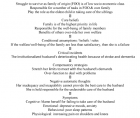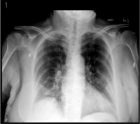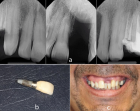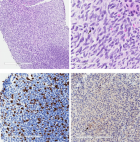Abstract
Short Review
Immunohistochemical expression of p53 and Fox A1 in epithelial ovarian cancer
Afaf T Elnashar* and Esraa M Youssef
Published: 20 May, 2022 | Volume 5 - Issue 2 | Pages: 061-066
Background: Ovarian cancer (OC) is the fifth cause of cancer mortality in females. There were an estimated 300,000 new cases of OC diagnosed worldwide in 2018, corresponding to 3.4% of all cancer cases among women. The high mortality rate of OC attributed to asymptomatic growth of the tumor leads to its diagnosis at advanced stages. About 85% - 90% of OC are epithelial including serous, endometrioid, clear cell, and mucinous carcinoma.
Aim: To study the immunohistochemical (IHC) expression of FOXA1 and p53 in epithelial OC and its association with prognostic indicators such as age, tumor size, stage, grade, and histological type.
Materials and methods: The study included 52 cases with EOC from the pathology department, faculty of medicine, Aswan, and Sohag Universities, in the period from January 2017 to December 2019. This study involved 52 patients with OC and a median age of 53 years. Different histological types were included as 37 serous, 12 mucinous, 1 case endometroid 2 cases clear cell OC. The study cases were classified into 22 Grade I, 16 Grade II, and 20 Grade III. About 22 cases were at stage I, 9 at stage II, 11 at stage III, and 10 at stage IV. Tissue sections were stained using the IHC technique with FOX A1 at a dilution of 1:100 and p53 at 1:100.
Results: A statistically significant correlation was found between FOX A1 expression and advanced patient's age, high grade, advanced stage, ruptured capsule, and ascites, regardless of tumor laterality. No significant association was found between p53 immunoexpression and the same clinic-pathological parameters although p53 was associated with serious type.
Conclusion: FOXA1 immunoexpression in EOC is considered a poor prognostic factor in EOC. FOXA1 could be a potential therapeutic target and prognostic marker in EOC.
Read Full Article HTML DOI: 10.29328/journal.cjog.1001109 Cite this Article Read Full Article PDF
Keywords:
Ovarian cancer; FOX A1; P53; Prognostic marker; Immunohistochemistry (IHC)
References
- Yoneda A, Lendorf ME, Couchman JR, Multhaupt HA. Breast and ovarian cancers: a survey and possible roles for the cell surface heparan sulfate proteoglycans. J Histochem Cytochem. 2012 Jan;60(1):9-21. doi: 10.1369/0022155411428469. PMID: 22205677; PMCID: PMC3283135.
- Chang HT, Chiu ML, Wang TY, Chen TC, Chang CL, Su TH, Wang KG, Wang KL, Yang YC, Chen JR. Effect of Chemotherapy, Laparoscopy, and Cytology on Stage IC Ovarian Clear Cell Carcinoma: A Long-Term, Single-Center Study. Int J Environ Res Public Health. 2020 Jan 13;17(2):491. doi: 10.3390/ijerph17020491. PMID: 31940991; PMCID: PMC7014224.
- Wang K, Guan C, Fang C, Jin X, Yu J, Zhang Y, Zheng L. Clinical significance and prognostic value of Forkhead box A1 expression in human epithelial ovarian cancer. Oncol Lett. 2018 Apr;15(4):4457-4462. doi: 10.3892/ol.2018.7899. Epub 2018 Jan 29. PMID: 29541214; PMCID: PMC5835846.
- Jelovac D, Armstrong DK. Recent progress in the diagnosis and treatment of ovarian cancer. CA Cancer J Clin. 2011 May-Jun;61(3):183-203. doi: 10.3322/caac.20113. Epub 2011 Apr 26. PMID: 21521830; PMCID: PMC3576854.
- Antoun S, Atallah D, Tahtouh R, Alaaeddine N, Moubarak M, Khaddage A, Ayoub EN, Chahine G, Hilal G. Different TP53 mutants in p53 overexpressed epithelial ovarian carcinoma can be associated both with altered and unaltered glycolytic and apoptotic profiles. Cancer Cell Int. 2018 Jan 30;18:14. doi: 10.1186/s12935-018-0514-2. PMID: 29422776; PMCID: PMC5791177.
- Chen L, Li L, Chen F, He D. Immunoexpression and prognostic role of p53 in different subtypes of epithelial ovarian carcinoma. J Biomed Res. 2012 Jul;26(4):274-7. doi: 10.7555/JBR.26.20110103. Epub 2012 Apr 24. PMID: 23554760; PMCID: PMC3596744.
- Meinhold-Heerlein I, Fotopoulou C, Harter P, Kurzeder C, Mustea A, Wimberger P, Hauptmann S, Sehouli J. The new WHO classification of ovarian, fallopian tube, and primary peritoneal cancer and its clinical implications. Arch Gynecol Obstet. 2016 Apr;293(4):695-700. doi: 10.1007/s00404-016-4035-8. Epub 2016 Feb 19. Erratum in: Arch Gynecol Obstet. 2016 Jun;293(6):1367. PMID: 26894303.
- Wang LL, Xiu YL, Chen X, Sun KX, Chen S, Wu DD, Liu BL, Zhao Y. The transcription factor FOXA1 induces epithelial ovarian cancer tumorigenesis and progression. Tumour Biol. 2017 May;39(5):1010428317706210. doi: 10.1177/1010428317706210. PMID: 28488543.
- Günakan E, Tohma YA, Karakaş LA, Akıllı H, Haberal AN, Ayhan A. Prognostic impact of p16 and p53 gene expressions in stage 1a epithelial ovarian cancer. Obstet Gynecol Sci. 2020 Jul;63(4):464-469. doi: 10.5468/ogs.19204. Epub 2020 Jun 19. PMID: 32550735; PMCID: PMC7393742.
- Kirkpatrick (Bundle: A Simple Guide to IBM SPSS Statistics - version 23.0, 14th + IBM SPSS Statistics Student Version 21.0 for Windows 14th Edition
- Hånell A. Discovery reliability. Journal of cerebral blood flow and metabolism: official journal of the International Society of Cerebral Blood Flow and Metabolism. 2019;39(6): 1185–1187.
- Vargas AN. Natural history of ovarian cancer. J Cancer Sci Ther. 2014;6:247–52.
- Peres LC, Cushing-Haugen KL, Köbel M, Harris HR, Berchuck A, Rossing MA, Schildkraut JM, Doherty JA. Invasive Epithelial Ovarian Cancer Survival by Histotype and Disease Stage. J Natl Cancer Inst. 2019 Jan 1;111(1):60-68. doi: 10.1093/jnci/djy071. PMID: 29718305; PMCID: PMC6335112.
- Cabasag CJ, Arnold M, Butler J, Inoue M, Trabert B, Webb PM, Bray F, Soerjomataram I. The influence of birth cohort and calendar period on global trends in ovarian cancer incidence. Int J Cancer. 2020 Feb 1;146(3):749-758. doi: 10.1002/ijc.32322. Epub 2019 Apr 30. PMID: 30968402; PMCID: PMC6786921.
- Prat J. Ovarian carcinomas: five distinct diseases with different origins, genetic alterations, and clinicopathological features. Virchows Arch. 2012 Mar;460(3):237-49. doi: 10.1007/s00428-012-1203-5. Epub 2012 Feb 10. PMID: 22322322.
- Wang K, Guan C, Fang C, Jin X, Yu J, Zhang Y, Zheng L. Clinical significance and prognostic value of Forkhead box A1 expression in human epithelial ovarian cancer. Oncol Lett. 2018 Apr;15(4):4457-4462. doi: 10.3892/ol.2018.7899. Epub 2018 Jan 29. PMID: 29541214; PMCID: PMC5835846.
- Razak Amanullah NA, Poothiode U, Vilasiniamma L. Expression of p53 in epithelial ovarian tumors. Indian J Pathol Microbiol. 2020 Apr-Jun;63(2):235-240. doi: 10.4103/IJPM.IJPM_526_19. PMID: 32317522.
- Ndukwe CO, Azuoma LA, Onyiaorah IV. Profile of p53 expression in EOC: A multicenter study from South-East Nigeria. CCIJ. 2018; 10.4103.
- Mohamed AO, Husain NE, Elmassry ER, Alnageeb L, Elhassan M, Abdelaziz MS. IHC expression of p53 in Type I and II EOC among Sudanese women: a cross-sectional study; F1000 Research. 2019; 8:1739.
- Zhang G, Zhao Y, Liu Y, Kao LP, Wang X, Skerry B, Li Z. FOXA1 defines cancer cell specificity. Sci Adv. 2016 Mar 18;2(3):e1501473. doi: 10.1126/sciadv.1501473. PMID: 27034986; PMCID: PMC4803482.
Figures:

Figure 1
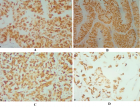
Figure 2

Figure 3

Figure 4
Similar Articles
-
Immunohistochemical expression of p53 and Fox A1 in epithelial ovarian cancerAfaf T Elnashar*,Esraa M Youssef. Immunohistochemical expression of p53 and Fox A1 in epithelial ovarian cancer. . 2022 doi: 10.29328/journal.cjog.1001109; 5: 061-066
-
Cost-analysis comparison of clinical risk assessment with and without ROMA for the management of women with pelvic massesKaylee A Underkofler,Alexandra J Morell,Rianne Esquivel,Francesca I DeSimone,M Craig Miller,Richard G Moore*. Cost-analysis comparison of clinical risk assessment with and without ROMA for the management of women with pelvic masses. . 2022 doi: 10.29328/journal.cjog.1001112; 5: 080-089
-
Meigs syndrome: About an uncommon case reportAziz Slaoui*,Hanaa Lazhar,Noha Amail,Najia Zeraidi,Amina Lakhdar,Aicha Kharbach,Aziz Baydada. Meigs syndrome: About an uncommon case report. . 2023 doi: 10.29328/journal.cjog.1001120; 6: 010-013
-
Minimally invasive cytoreductive surgery in advanced ovarian cancer: A nonselected consecutive series of robotic-assisted casesNatalie Shammas*, Rosa Avila, Christopher Khatchadourian, Erland Laurence Spencer-Smith, Lisa Stern, Steven Vasilev. Minimally invasive cytoreductive surgery in advanced ovarian cancer: A nonselected consecutive series of robotic-assisted cases. . 2023 doi: 10.29328/journal.cjog.1001126; 6: 032-037
-
Fibrothecal Tumors of the Ovary - Case ReportM Lamrani*,K Lakhdar,S Sardaoui,Y Alami,F Tijami,H Hachi,Z El-Hanchi,A Baydada. Fibrothecal Tumors of the Ovary - Case Report. . 2024 doi: 10.29328/journal.cjog.1001177; 7: 117-119
Recently Viewed
-
Advancing Forensic Approaches to Human Trafficking: The Role of Dental IdentificationAiswarya GR*. Advancing Forensic Approaches to Human Trafficking: The Role of Dental Identification. J Forensic Sci Res. 2025: doi: 10.29328/journal.jfsr.1001076; 9: 025-028
-
Scientific Analysis of Eucharistic Miracles: Importance of a Standardization in EvaluationKelly Kearse*,Frank Ligaj. Scientific Analysis of Eucharistic Miracles: Importance of a Standardization in Evaluation. J Forensic Sci Res. 2024: doi: 10.29328/journal.jfsr.1001068; 8: 078-088
-
Sinonasal Myxoma Extending into the Orbit in a 4-Year Old: A Case PresentationJulian A Purrinos*, Ramzi Younis. Sinonasal Myxoma Extending into the Orbit in a 4-Year Old: A Case Presentation. Arch Case Rep. 2024: doi: 10.29328/journal.acr.1001099; 8: 075-077
-
Toxicity and Phytochemical Analysis of Five Medicinal PlantsJohnson-Ajinwo Okiemute Rosa*, Nyodee, Dummene Godwin. Toxicity and Phytochemical Analysis of Five Medicinal Plants. Arch Pharm Pharma Sci. 2024: doi: 10.29328/journal.apps.1001054; 8: 029-040
-
Antibacterial Screening of Lippia origanoides Essential Oil on Gram-negative BacteriaRodrigo Marcelino Zacarias de Andrade, Bernardina de Paixão Santos, Roberson Matteus Fernandes Silva, Mateus Gonçalves Silva*, Igor de Sousa Oliveira, Sávio Benvindo Ferreira, Rafaelle Cavalcante Lira. Antibacterial Screening of Lippia origanoides Essential Oil on Gram-negative Bacteria. Arch Pharm Pharma Sci. 2024: doi: 10.29328/journal.apps.1001053; 8: 024-028.
Most Viewed
-
Evaluation of Biostimulants Based on Recovered Protein Hydrolysates from Animal By-products as Plant Growth EnhancersH Pérez-Aguilar*, M Lacruz-Asaro, F Arán-Ais. Evaluation of Biostimulants Based on Recovered Protein Hydrolysates from Animal By-products as Plant Growth Enhancers. J Plant Sci Phytopathol. 2023 doi: 10.29328/journal.jpsp.1001104; 7: 042-047
-
Sinonasal Myxoma Extending into the Orbit in a 4-Year Old: A Case PresentationJulian A Purrinos*, Ramzi Younis. Sinonasal Myxoma Extending into the Orbit in a 4-Year Old: A Case Presentation. Arch Case Rep. 2024 doi: 10.29328/journal.acr.1001099; 8: 075-077
-
Feasibility study of magnetic sensing for detecting single-neuron action potentialsDenis Tonini,Kai Wu,Renata Saha,Jian-Ping Wang*. Feasibility study of magnetic sensing for detecting single-neuron action potentials. Ann Biomed Sci Eng. 2022 doi: 10.29328/journal.abse.1001018; 6: 019-029
-
Pediatric Dysgerminoma: Unveiling a Rare Ovarian TumorFaten Limaiem*, Khalil Saffar, Ahmed Halouani. Pediatric Dysgerminoma: Unveiling a Rare Ovarian Tumor. Arch Case Rep. 2024 doi: 10.29328/journal.acr.1001087; 8: 010-013
-
Physical activity can change the physiological and psychological circumstances during COVID-19 pandemic: A narrative reviewKhashayar Maroufi*. Physical activity can change the physiological and psychological circumstances during COVID-19 pandemic: A narrative review. J Sports Med Ther. 2021 doi: 10.29328/journal.jsmt.1001051; 6: 001-007

HSPI: We're glad you're here. Please click "create a new Query" if you are a new visitor to our website and need further information from us.
If you are already a member of our network and need to keep track of any developments regarding a question you have already submitted, click "take me to my Query."







